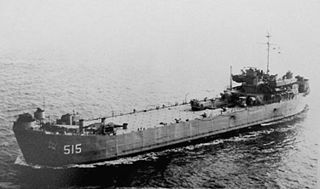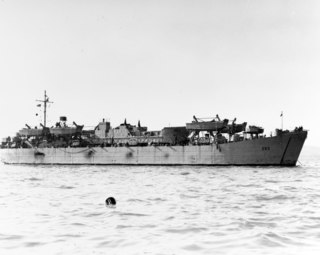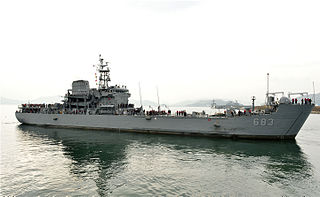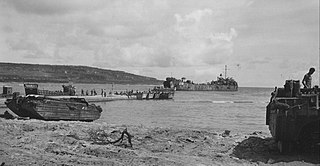
Landing Ship, Tank (LST), or tank landing ship, is the naval designation for ships first developed during World War II (1939–1945) to support amphibious operations by carrying tanks, vehicles, cargo, and landing troops directly onto shore with no docks or piers. This enabled amphibious assaults on almost any beach.

The Turkish Naval Forces, or Turkish Navy is the naval warfare service branch of the Turkish Armed Forces.

A green-water navy is a maritime force that is capable of operating in its nation's littoral zones and has limited competency to operate in the surrounding marginal seas. It is a relatively new term, and has been created to better distinguish, and add nuance, between two long-standing descriptors: blue-water navy and brown-water navy.

The Endurance-class tank landing ships (LST) are the largest class of ships in the Republic of Singapore Navy (RSN). They were designed and built by Singapore Technologies (ST) Marine to replace the old County-class tank landing ships. The four ships form the Third Flotilla of the RSN.

USS Caddo Parish, originally named LST-515, was an LST-491-class tank landing ship built for the United States Navy during World War II. Like many of her class, she was not originally named and was properly referred to by her hull designation. On 1 July 1955, she was given the name Caddo Parish, named after Caddo Parish, Louisiana, she was the only U.S. Naval vessel to bear the name.

USS LST-849 was an LST-542-class tank landing ship in the United States Navy during World War II. Late in her U.S. Navy career, she was renamed Johnson County (LST-849)—after counties in Arkansas, Georgia, Illinois, Indiana, Iowa, Kansas, Kentucky, Missouri, Nebraska, Tennessee, Texas, and Wyoming—but never saw active service under that name.

Go Jun Bong-class tank landing ship is an amphibious landing ship class of the Republic of Korea Navy.

The Cheon Wang Bong-class tank landing ship is an amphibious landing ship class of the Republic of Korea Navy.

USS LST-924 was an LST-542-class tank landing ship in the United States Navy. Like many of her class, she was not named and is properly referred to by her hull designation.

Persistence(209) is the third ship of the Endurance-class landing platform dock of the Republic of Singapore Navy.

USS LST-1010 was an LST-542-class tank landing ship in the United States Navy during World War II. She was transferred to the South Korean Navy as ROKS Un Bong (LST-807).

The Teluk Semangka class is a class of tank landing ships operated by the Indonesian Navy. The ships were built by the Korea-Tacoma Shipyard, Masan, South Korea in the early 1980s.

USS LST-283 was a LST-1-class tank landing ship in the United States Navy during World War II. She was later sold to the Peruvian Navy and renamed BAP Chimbote (LT-34).

ROKS Go Jun Bong (LST-681) is the lead ship of the Go Jun Bong-class tank landing ship in the Republic of Korea Navy.

ROKS Bi Ro Bong (LST-682) is a Go Jun Bong-class tank landing ship in the Republic of Korea Navy.

ROKS Hyang Ro Bong (LST-683) is a Go Jun Bong-class tank landing ship in the Republic of Korea Navy.

USS LST-227 was a LST-1-class tank landing ship in the United States Navy during World War II. She was later sold to South Korean Navy as ROKSDeok Bong (LST-808).

USS LST-218 was a LST-1-class tank landing ship in the United States Navy during World War II. She was later sold to South Korean Navy as ROKSBi Bong (LST-809).

















